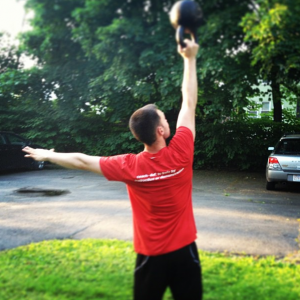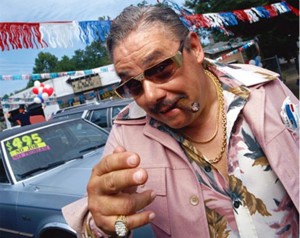Fitness Road Rules
 Everyone is looking for “the secret”.
Everyone is looking for “the secret”.
The nutrition guru swears it’s the juice detox or the coconut oil. The “guy at the gym” preaches interval training and kettelbells. Your cousin swears by Crossfit and only eats paleo and his girlfriend credits Pure Barre for her “Selteresque” tush.
Depending on your goal any of these approaches may or may not work. A smart man once told me “everything works for 6 weeks.”
In pursuing of our health and fitness goals there are many roads to Rome, but why then do so many people swerve off into the ditch?
Unfortunately, the majority of exercisers will miss their mark. We know that exercise adherence is a problem, with a number of studies estimating that over 50% of people will drop out of their attempted exercise routine within 6-12 months.[i]
What I’ve found is that on the journey to our fitness goals there is often too much focus on what vehicle we’re driving and how fast we can get there and not enough focus on simply staying on the road. The average gym-goer is drunk at the wheel but that won’t stop them from driving.
Barreling down the road with a skewed sense of direction and nothing more than a learner’s permit we’ll start headstrong on our exercise journey fueled by unrealistic social standards, media influences and a reality check courtesy of our Doctor or our favorite pair of denims that no longer love us back.
Distractions along the roadside are impossible to ignore and the rebel inside of you views the speed limit as a polite suggestion in hopes of getting to your destination quicker. More often than not our road trip will end early and we’ll find ourselves stranded on the shoulder of the fitness highway, calling for help , desperately trying to get back on the road.
Analogies aside, most exercisers do a poor job of planning for their goals (if they plan anything at all) and do not understand the rules of the fitness road. Below are some important things to consider before embarking on your fitness journey.
What Is Your Destination?
“The goal is to keep the goal the goal” – Daniel John.
This is the truest and simplest piece of training life advice I have ever received.
Ask yourself: What am I ultimately working towards? What is my destination?
Whether clearly stated or not everyone who is exercising has a goal. The very act of engaging in intentional physical activity requires some sort of motivator. Everyone who inside a gym or out for a run is pursuing “something” whether it’s conscious or not. For the average exerciser the goal will usually fall into 1 or 2 categories..…
1). Look better naked, burn fat and add muscle. ie). “I want to get shredded for the beach”
2). Improve or maintain overall health. ie). “My doctor said I need to start exerciseing or I’m gonna die!”
Statements like this are a good place to start however, we need to paint a clearer picture of our destination if we want to get there safe and sound. It is especially important to be as specific as possible when we are fairly new to training or are pursuing a goal that is unfamiliar to us.
Think of it this way.
If you were planning a road trip to Boston for the first time and wanted to visit Fenway Park you probably wouldn’t just type “Boston” into the GPS and start driving would you?
I’d suggest that you enter a specific address somewhere around 4 Yawkey Way otherwise you may find yourself lost driving around Southie or Dorchester with Fenway nowhere in sight. This seems obvious in the context of traveling somewhere but this is exactly what people do when planning out their fitness journey.
Having a generic goal will lead us in a very generalized direction often taking us somewhere we do not want to end up. When it comes to pursuing goals, especially ones we are unfamiliar with we need to clearly define the coordinates of our destination.
For example, take “John” a middle aged, sedentary and overweight office worker who is new to training. A good goal statement by him may state:
“In the next 4 months I am going to lose 20 lbs of body fat, reduce my triglycerides to below 200 and lower my resting heart rate to under 70 beats per minute.”
John gave himself 3 specific goals and a very realistic timeline to work with. Now that has established his destination he can work backwards to his current position and map out HOW he will get there and WHAT vehicle he will take to get there. (More on this later).
With end goals as far off and as unfamiliar as John’s it’s important that we have some checkpoints along the way to ensure we’re heading in the right direction. If we were traveling in the old days it would have been a compass, today we have GPS but in the fitness world we use progress goals.
In our client John’s situation it would mean reassessing his weight, body composition, resting heart rate and blood lipid numbers at regularly scheduled intervals during the training process. If John wasn’t making steady progress towards his goal or was backtracking then he would know he had to regroup and find an alternate route his destination. Wrong turns happen, it’s not a big deal people get lost all the time but if we don’t check in with our GPS we may never know until we completely miss our mark.

“A tad? A tad, Lloyd? You drove almost a sixth of the way across the country in the wrong direction!”
How Are You Getting There?
So we’ve written out our goals and defined our destination but it is important to define “HOW” we will get there. With out action all we have are words. We need to define the behaviors necessary to get us to our goals.
What behaviors are going to support your training goals?
Your daily health and training behaviors are like the rules of the road. When it comes to training, just like when you’re behind the wheel, making consistently smart decisions will ensure a safe arrival at your destination.
Often when in pursuit of a new goal trainees become overly excited in hopes of getting to their destination more quickly. With this excitement comes an all out attitude where caution and common sense is often thrown to the wind. This can be a recipe for disaster.
This phenomenom can be witnessed most readily in January and February when all the gym newbs are oozing motivation due to their freshly waxed New Years Resolutions. Inevitably, the majority of these types are nowhere to be seen by March 1st because somewhere along the way the wheels came off.
Remember that a fast start does not guarantee a timely finish. Speeding and taking shortcuts will get you into an accident or pulled over by the 5-0 and delay your arrival at your destination. When it comes to training, hangs up like this are what stagnate progress and leave people short of reaching their intended goals.
Write A Behavioral Checklist
“We are what we repeatedly do” – Aristotle
The most powerful tool you can employ for pursuing a goal is a behavior checklist. Write out a list of the “core behaviors” that are 100% necessary for you to practice to reach your goal. Review this list daily to ensure you are staying on track. Breaking down your goals into daily behaviors can make lofty long terms goals seem much more manageable. Framing your journey into daily practices will narrow your focus on what matters most, your behaviors.
Let’s refer back to our previous example of “John” who wants to lose 20 lbs, lower his resting hear rate and improve his blood lipid profile. John’s behavior checklist may look something like this.
– 40 Minutes of strength training 3x week
– 20 -30 minutes of steady state aerobic exercise on the Airdyne bike 3 x week
– Maintain caloric intake under 2,200 calories/day
– Avoid all processed foods
– Drink at least 80 oz of water per day
– Sleep at least 6 hours per night
These are all behaviors that if John practices daily will ensure he is making progress towards his goal.
When first starting out it is important to pick behaviors that are realistic so that we can see success and build momentum. Too much ambition early on can easily leave us worn out or injured right out of the gate. If John had written down that intended to strength train and do 1 hour of cardio 5 days a week then he would likely fail, leaving him stagnant. Over time if John is successful in completing his behaviors he can replace them with more challenging practices so that he continues progressing forwards. Pick behaviors that are achievable and allow you room for improvement.
On the other a more experienced trainee that is familiar with the process of training for a specific goal may not require such meticulous planning. Similarly, once we have gained familiarity driving around a region we could navigate that area without the use of a GPS.
For example, cutting down body fat is something I do very frequently. Yearly, as the summertime comes around and the pressure of taking my shirt off rises I focus on getting “leaner” and will lose 10-15 lbs working to drop below 10% body fat. Years ago this endeavor was challenging for me. I struggled with nutritional strategies and training methods and would miss my mark often failing to lose weight or dieting myself to exhaustion. With experience and planning I eventually found the strategies that worked best for me to lose body fat and now I can reproduce those results fairly easily without much thought or prior planning.
However, knowing when and where the traffic jams happen and where you can take a shortcuts is something that comes with experience behind the wheel. A homespun sense of direction only works in places that you are native to. No matter how experienced you are at training, new goals are unfamiliar territory. Once you venture off to another city, you have to pull the map back out no matter how long you’ve had your license.
What Vehicle Are You Taking?
Now that we have laid out our goals and know where we are headed we have to figure out what vehicle we are going to use to get there. If we’re continuing to think about training in terms of driving, your “vehicle” is akin to your training or nutrition methods.
In life there are a lot of different vehicles we can choose from. Almost all of them can get us from point A to point B, albeit some will be more effective than others. The same can be said when it comes to training and nutritional strategies.
Some vehicles are safer than others, not everyone is meant to drive a racecar and that soccer mom is probably better off in a Volvo. Crossfit may work for a very small percentage of the population but it can be disasterous for the average trainee.
Everyone has preferences that fit their personality. The macho guy might feel right at home in a big truck and the teenage girl might prefer to fly around in her pink sports car (I understand that these are stereotypes). People are going to naturally gravitate towards training cultures that they identify with. If you love spin class and it’s getting you to your goals and you feel healthy then go for it. If you are kettlebell junkie and it works for you then by all means swing away.
Economics also matter. Maybe you can afford a Ferrari, but that blue-collar guy can get around just fine in his dependable Toyota Corolla. Some people want personal training but for others group training or paying $10/month at Planet Fitness is their economic reality.
When it comes to training methods, just like vehicles there are basic standards that every variety should adhere to. Every car has to pass inspection to be street legal and as far as I am concerned so should every exercise method. When picking my training methods I have some basic rules that I use to audit my choices as they relate to my goals.
– Do No Harm
– Progressive Overload
– Joint-By-Joint Approach
– SAID Principle
**(There are probably a bunch more but that is for another article on a another day)There are many different methods that can meet these standards just like there are many different types of cars that can pass inspection. As long as we can adhere to those standards, the method you choose should be the one that is right for you and your goals. My suggestion it that you take a few different “vehicles” on a test-drive and find the right one.
What I’m saying is pick the training method that is the right one for you, at the right time! You’re not going to take a Maserati off-roading and you’re not going to take a Jeep to the race track but there is a time and a place for both. Choose accordingly and don’t be afraid to change it up when you need to. Some people will drive the same car for years, some people change cars all the time and some people have a 4-car garage with multiple choices. I know people who have sworn by long distance running their whole life and it’s worked for them while some trainees prefer to adjust their goals and methods frequently. Pick the training methods that fit the best for your lifestyle and the goals you have planned.

Don’t let a sleazy salesman sell you a vehicle that isn’t right for you.
Never Stop Traveling
Ultimately, our fitness journey should be a lifetime one. Adopting a healthy lifestyle means constantly pursuing health and fitness through different avenues and seeking out new challenges. You should be a fitness road warrior of sorts, whose life is comprised of continuous adventures around the fitness map in a number of different vehicles. It’s likely that your methods and goals will always be changing, and you’ll probably have some familiar goals that you will continually revisit. But, in the big picture of health, what methods you choose are not the most important thing. What is most important is that you you stay on the road, continue exploring and never ever stop moving.
[i] Seefeldt, Vern, Robert M. Malina, and Michael A. Clark. “Factors affecting levels of physical activity in adults.” Sports Medicine 32.3 (2002): 143-168.